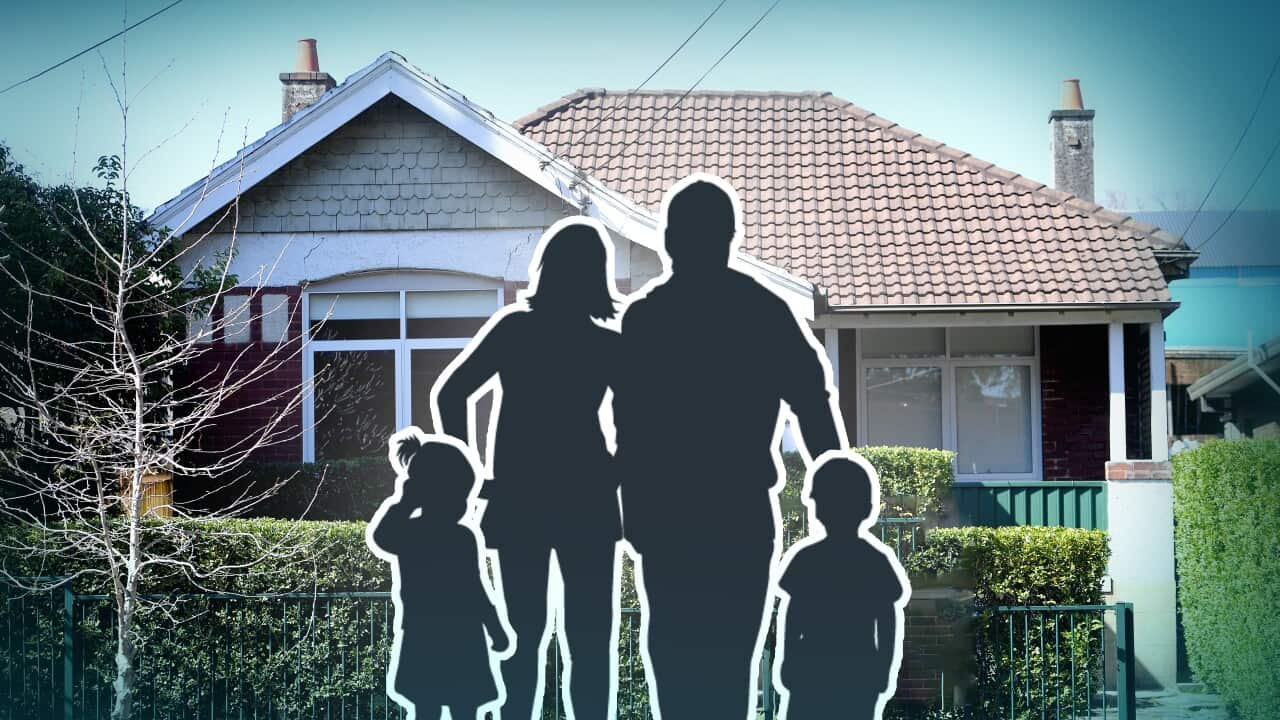The first night Pamela (not her real name) returned to her childhood home to live with her parents — at age 42 and with her husband and two children in tow — it "just felt strange".
"It was very strange lying in the bed, going to sleep with my husband, knowing my parents were in the other bedroom, my boys were in another room. And I was in my brother's old bedroom.
"There's been lots of tears, put it that way."
Pamela's homecoming was not something she ever expected to experience. She had left home at age 20 and bought her own two-bedroom apartment on Sydney's affluent Lower North Shore when she was 27-years-old, before getting married. She paid her mortgage comfortably on one income for 14 years.
But the introduction of travel restrictions due to the COVID-19 pandemic destroyed her 15-year-old business. By October 2022, she had racked up around $6000 in debt.
"We were behind on strata bills, we were behind on council rates, because we just didn't have the income to cover it," she told SBS News.
Even though Pamela's husband worked five days a week at two different jobs, and she was working five half-days a week, they still couldn't cover their expenses.
The combined income from both of their casual jobs brought in around $70,000 but this was not enough to cover their debt and keep payments up on their $340,000 mortgage, which rose to around $2600 a month, after at least eight rate rises.

The Reserve Bank of Australia has increased the cash rate 13 times since May 2022.
Pamela is grateful to her parents, who suggested she move back in with them after they realised the financial stress she was under. But it hasn't been an easy move and Pamela often feels guilty about the arrangement.
"The number of times I've cried because I've put my parents in this situation, and when they start to argue and then I go 'it's all our fault'. It's awful," she said.
"You are meant to be a grown adult, and they [her parents] are meant to be living their life, and you've turned everything upside down."
The number of times I've cried because I've put my parents in this situation, and when they start to argue and then I go 'it's all our fault'. It's awfulPamela
Pamela said her mother was a cancer survivor and had retired, so was previously enjoying a quiet life and not having to work.
"And then we come with two very energetic, loud boys. So I think everyone's had to adjust," she said. "I've lived on my own since I was 20, I'm now 43, so it is an adjustment."
But there have been benefits on both sides, with her husband performing gardening and maintenance at the house, and her parents babysitting the children so Pamela and her husband can work more hours. He is now working six-and-a-half days a week, and Pamela has increased her workload to four full days.
Her parents' three-bedroom house also has a pool and front and back yards, which means her children can easily play basketball, cricket and soccer, something they didn't have easy access to when they were living in their two-bedroom apartment. The increased time together means the children have created a close bond with their grandparents.
"We've had memories that we could never have created with my parents and their grandchildren if we were living in an apartment [and only seeing their grandkids once a week]," Pamela said.
Despite this, Pamela does feel bad for her parents, who were used to having their own space, as well as her husband, "as it's not his family".
"The guilt eats at me, but it's that or [being] homeless, and you have to put your boys first. You have to swallow your pride, which is sad to do, but you have to do everything for your children."
Feelings of shame around multi-generational living
Pamela also feels stigma around her new living arrangement because it's not common in her community, even though it's widespread among those from different cultural backgrounds, including her husband's.
She has only told half of her friends about their financial situation, the other half believe Pamela has moved back in with her parents to save for a bigger house. Part of the shame comes from the fact that she lives in an affluent area, where most people are "pretty comfortable".
"So when you get into these situations, it sounds really awkward, especially when all your friends own their own houses, have two fancy cars, and kids go to private schools," Pamela said.
"We have to put on a brave face because we don't want the children to see us — this has impacted both of our mental health — and my parents, they're stressed for us, they're in tears because they never anticipated our lives to be like this."
While Pamela does have a number of friends who have moved in with their parents for short periods of time, it's not under such "dire circumstances" and it's mostly attributed to other reasons, such as renovations, moving interstate or saving a house deposit.
"My eldest does say, 'when are we moving back to our home? Or when are we going to have our own house?'"
Multi-generational households on the rise
While it's not common for Australians to live with their grandparents, it appears to be a growing trend and may become even more so in the future.
Australian Housing and Urban Research Institute (AHURI) managing director Dr Michael Fotheringham said multi-generational living was already popular among some cultural groups in Australia but the rising cost of living appeared to be driving more families to adopt this arrangement.
"It is definitely a growing trend for adult children with kids of their own, to move back in with their parents, or in fact, not move out in the first place and have three generations living in a household by choice, for a range of reasons," Fotheringham told SBS News.
"Some of the work we've done in the last few years has been really clear that cost of living, and in particular cost of housing, are real drivers of this trend."

House prices in Australia continue to bounce back after a short dip in the market in 2022. Source: Getty / Lisa Maree Williams
Older research from the AHURI found almost one-quarter of households in Sydney (23.6 per cent) were comprised of two or more generations of related adults in 2006.
Home builders have also noted the trend and have started promoting homes with floorplans designed specifically for multi-generational families.
G.J. Gardner Homes chief operating officer for Australia and New Zealand, Chris Thornton, said its local franchise offices had observed a rise in enquiries for multigenerational homes since 2021.
These homes can feature multiple master bedrooms, larger kitchens and living rooms, multiple living areas, and homes with a number of self-contained zones that provide private, independent areas for children or parents to enjoy.

An example of a floorplan designed by G.J. Gardner for multi-generational living
Thornton said multi-generational living has long been popular with immigrant families and demand from these communities had increased following the re-opening of Australia's borders and the increase in immigration after COVID-19 lockdowns. Families are also looking for ways to provide care and support for elderly parents or grandparents.
He believes cost of living is another factor. Thornton said some parents with young families appeared to be planning for the future as they expected their children to live at home longer due to increases in cost of living and housing.
"Our intergenerational home designs are only increasing in popularity," he said.
"The current inflated cost of living pressures and rising housing costs, particularly in areas such as Sydney and Melbourne, have made it increasingly difficult for families to afford separate homes."
Australians may need to adapt to the idea of multi-generational living
Fotheringham said multi-generational households would likely only increase and Australians may have to become more comfortable with the idea.
According to financial comparison site Canstar, 13 interest rate hikes since May 2022 may have increased mortgage repayments by up to 62 per cent on a $600,000 loan over 30 years. This could mean households are shelling out an extra $1562 each month.
A couple earning a total household income of $191,162 could be spending more than a third of their pay packet on mortgage repayments if they have an average loan of $628,449.
The reality is housing in this country continues to get more expensive, far more rapidly than wages go upDr Michael Fotheringham
In states such as NSW, where average loan sizes are even higher, the couple could be spending as much as 44 per cent of their after-tax income on repayments.
"The reality is housing in this country continues to get more expensive, far more rapidly than wages go up," Fotheringham said.
"People are looking to diverse solutions, and this (multi-generational housing) is actually one of the more sensible and straightforward ones."
Holding out for an inheritance
Pamela said she would rather move in with her parents than pretend everything was fine while shouldering thousands of dollars in debt. She believes some families continue to rack up debt in order to preserve the appearance of their lifestyle and are waiting until they receive their inheritance to pay these off, something she doesn't want to do.
Unfortunately, many young people may not be able to afford the homes their parents could, unless they get financial help or an inheritance.
"We're never going to be able to afford on a normal income to buy a $3 million house without some sort of inheritance ... it's just not possible unless you're both earning well over $200,000 each," she said.
"I think people are going to slowly realise it (the high price of housing) is not worth it."
While navigating some of the challenges associated with multigenerational living could be difficult, Fotheringham believes it is a good thing.
"Understanding the roles people play — who's in charge — who's the parent here and so on, is something to navigate but it's something that people have done for thousands of years."
Pamela said her family had created some amazing memories, which was the silver lining in their situation.
"You just have to get through each day and be with the ones you love. That's it at the end of the day."














